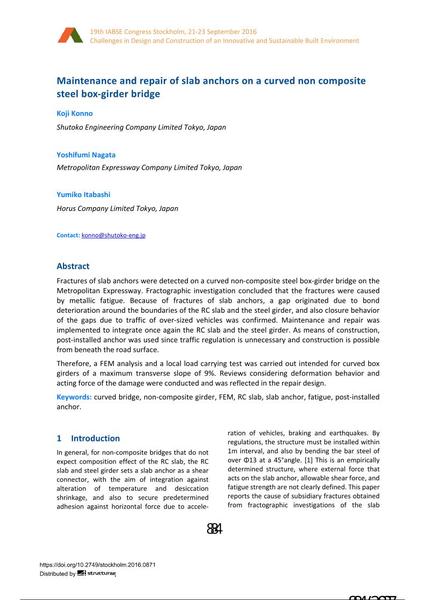Maintenance and repair of slab anchors on a curved non composite steel box-girder bridge

|
|
|||||||||||
Bibliographic Details
| Author(s): |
Koji Konno
(Shutoko Engineering Company Limited Tokyo, Japan)
Yoshifumi Nagata (Metropolitan Expressway Company Limited Tokyo, Japan) Yumiko Itabashi (Horus Company Limited Tokyo, Japan) |
||||
|---|---|---|---|---|---|
| Medium: | conference paper | ||||
| Language(s): | English | ||||
| Conference: | IABSE Congress: Challenges in Design and Construction of an Innovative and Sustainable Built Environment, Stockholm, Sweden, 21-23 September 2016 | ||||
| Published in: | IABSE Congress Stockholm, 2016 | ||||
|
|||||
| Page(s): | 884-891 | ||||
| Total no. of pages: | 8 | ||||
| Year: | 2016 | ||||
| DOI: | 10.2749/stockholm.2016.0871 | ||||
| Abstract: |
Fractures of slab anchors were detected on a curved non-composite steel box-girder bridge on the Metropolitan Expressway. Fractographic investigation concluded that the fractures were caused by metallic fatigue. Because of fractures of slab anchors, a gap originated due to bond deterioration around the boundaries of the RC slab and the steel girder, and also closure behavior of the gaps due to traffic of over-sized vehicles was confirmed. Maintenance and repair was implemented to integrate once again the RC slab and the steel girder. As means of construction, post-installed anchor was used since traffic regulation is unnecessary and construction is possible from beneath the road surface. Therefore, a FEM analysis and a local load carrying test was carried out intended for curved box girders of a maximum transverse slope of 9%. Reviews considering deformation behavior and acting force of the damage were conducted and was reflected in the repair design. |
||||
| Keywords: |
fatigue FEM Curved Bridge non-composite girder RC slab slab anchor post-installed anchor
|
||||

